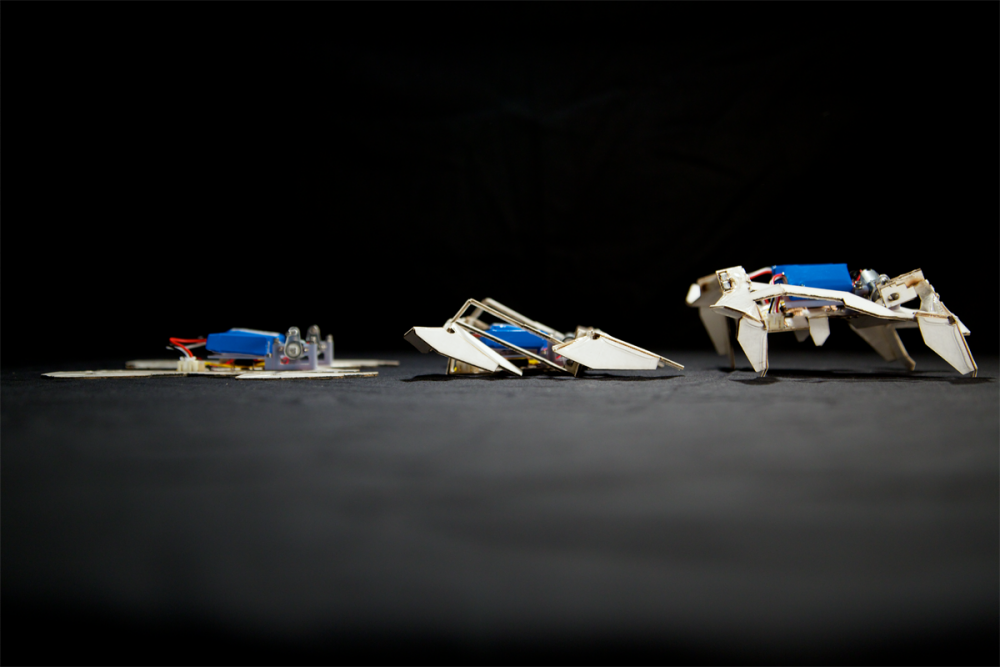 A team from Harvard's Wyss Institute, Harvard's SEAS, and MIT built an autonomous robot that starts out as a single composite sheet programmed to fold itself into a complex shape and crawl away without any human intervention. Credit: Harvard's Wyss Institute
A team from Harvard's Wyss Institute, Harvard's SEAS, and MIT built an autonomous robot that starts out as a single composite sheet programmed to fold itself into a complex shape and crawl away without any human intervention. Credit: Harvard's Wyss Institute
An origami-inspired robot has been developed with the capability to self-assemble into a complex shape in just four minutes - and crawl away afterwards.
The robot, programmed to walk away at a speed of one-tenth of a mile per hour after assembly, was build using surprisingly uncomplicated components, including Shrinky dinks™ and paper.
The research was conducted by a team of engineers and computer scientists including Rob Wood and Sam Felton from the Wyss Institute, SEAS, and the Massachusetts Institute of Technology (MIT), and has been described in Science.
The research could have a great impact on the design and assembly of robots, with progress in speed, cost and automation. The building process would also be complementary to 3D printing, which is becoming increasingly important in manufacturing.
The team has been designing a number of robots over the last few years, of which this is the first one capable of full self-assembly without the need for any human intervention.
With the aid of computer design tools, Felton decided on the fold pattern and suitable design after trying around 40 prototypes. He fabricated the initial sheet using just a solid ink printer, a laser machine, and his hands.
Self-folding robots
He then added two batteries, two motors, and a microcontroller to the flat sheet, with the microcontroller functioning as the 'brain' of the robot. The sheet itself was made of Shrinky dinks™ (or polystyrene) and paper, with one flexible circuit board in between.
The sheet also comprised hinges pre-programmed to fold in a specific manner. Each hinge included an embedded circuit, which when signaled by the microcontroller produced heat. This heat causes self-folding of the composite sheet in a specific sequence.
"Getting a robot to assemble itself autonomously and actually perform a function has been a milestone we've been chasing for many years”.
Senior Author Rob Wood
After four minutes, the cooling of the hinges causes hardening of the polystyrene, which in turn results in a stiffening of the robot. The microcontroller then commands the robot to walk away. This complete sequence uses up energy equivalent to that in a single AA alkaline battery.
The functioning of the robot is linked to a timer, which waits for 10s after the installation of the batteries to start the folding process.
According to Felton, this could be modified so that folding is triggered by a pressure or temperature sensor.
This folding technique is inspired in part by natural processes, particularly from the manner in which linear amino acid sequences fold into complex proteins with advanced functions.
This amazing research follows the recent news of a 3D printed, phase-changing material developed by MIT that could lead to robots that can easily deform into different shapes.
Interestingly, University of Massachusetts at Amherst has also released news today of research into how origami could be utilized to create new materials.
It seems that great leaps forward are being made with regards to giving robots greater control over their own destiny, simply via the materials used to build them and the way in which these are arranged.
References
Disclaimer: The views expressed here are those of the author expressed in their private capacity and do not necessarily represent the views of AZoM.com Limited T/A AZoNetwork the owner and operator of this website. This disclaimer forms part of the Terms and conditions of use of this website.